“We have to change the way our society views women.” –Aly Raisman, ESPN Magazine
Maroon 5 & Cardi B’s “Girls Like You” got me thinking. This masterpiece of videography includes various women who have inspired millions. These include familiar faces, such as Wonder Woman Gal Gadot, J-Lo, Ellen DeGeneres. But some faces aren’t so familiar. The video draws a curious viewer like myself to ponder “who’s that woman?” and search it up on Google; as a result, I’ve learned about a few amazing women I’ve haven’t really heard of elsewhere.
“Girls Like You” by Maroon 5 feat. Cardi B (video directed by David Dobkin)
Ilhan Omar: the first Somali-American Muslim legislator to be elected to office in the United States.
Amani Al-Khatahtbeh: author, tech-entrepreneur and founder of MuslimGirl, an online magazine for Muslim women.
Jackie Fielder: an activist and organizer for Mazaska Talks in solidarity for Standing Rock.
Chloe Kim: just kidding, of course I know who she is already. Also, I’m so glad they included Tiffany Haddish here.
(This article from Billboard helps.)
Aly Raisman: Olympic Gold Medalist in gymnastics, and one of the heroes who spoke out in the case against sexual abuser Jeffrey Nasser. Adam Levine holds her hand in the video, and she stands tall wearing a shirt that says “Always Speak Your Truth.” My god-family LOVES watching Olympic gymnastics for some reason, so I already knew about her and the Fierce Five in the 2012 London Olympics. But this woman is a hero not only in her athletic accomplishments; she continues to be a heroic voice- “challenging the very institutions she led to glory” (Mina Kimes, ESPN). And in my humble opinion, everyone should hear her truth.
(I just received this month’s ESPN magazine in the mail, and this article. “Aly Raisman Takes the Floor,” by Mina Kimes is worth the read.)
Maybe I sound like a broken record. Maybe I’m not the best voice regarding this because as a male, I don’t completely understand how much more difficult it is for it to be a woman in this world.
But NO. I shouldn’t shut up because it’s repetitive. I shouldn’t stay quiet because it’s uncomfortable to talk about the constant mistreatment of women throughout the history of mankind.
Women deserve to be celebrated, and they deserve equality in voice, salary, and everything else. That’s why I love what Maroon 5 did with their recent hit “Girls Like You.” With a simple video, they’ve opened the door for us viewers to learn more about a number of fantastic, inspiring women.
But it shouldn’t stop there. To finish my typed monologue, I’m going to share about three amazing women who have inspired my life greatly.
I grew up with a strong-willed mother. My father never looked down at her; rather, they stood side-by-side and provided an amazing childhood for me and my brother. She is my hero.
My first video game was Backyard Soccer, through which Brandi Chastain became my favorite soccer player. Really. I’m serious; my dad would record her US pro soccer games. The San Jose CyberRays.
My favorite teacher in high school was Mrs. Gall, a former computer engineer who became a teacher because she loved inspiring young minds. As a kid, I was always hesitant to follow my father’s footsteps as a computer scientist, because I wanted to do something “cooler.” In short, Mrs. Gall helped inspire me and guide me throughout high school and discover my own interest in computer science.
If you’re still reading this for some reason (I don’t think many people actually read my blog), I challenge you to write down at least 3 inspiring women in your life. It doesn’t have to be a blog post- it could be in your journal, or even a note on your phone.
Because Aly is completely right: we have to change the way our society views women.”

TV Episode: Parks and Recreation S6E11: “Farmer’s Market
GIFs from, knope.gifglobe.com
Once my brother booked a flight across the country to visit a friend. Later, he found out that his friend “suddenly” had to leave town the same week my brother was visiting… but the plane tickets were paid for.
As my brother shared this to my family, I immediately went into solution mode.
Bro, you got two choices: pay the cancellation fee, OR go anyways and enjoy the vacation without your friend.
My brother hated my response… you’re not helping. please stop talking.
I was confused. Why??? I’m just trying to help.
I didn’t realize that I was being a terrible little brother. I was minimizing my brother’s dilemma. Not only that, I was making it so that his frustrations weren’t worth it. I was saying move on... in the most pompous, arrogant way.
My brother is a grown man in his late 20s, and I was just a college kid. Of course he knew all the solutions I was spitting out. He’s not dumb. In fact, he’s travelled 10x more than me. However, he was lamenting a bad situation that he had just encountered.
My best answer as a little brother and best friend should have been: “Bro, that really sucks.”
(in the end, my brother’s friend was actually there during his visit, so things worked out)
We can see this in Parks and Recreation too. In S6E12, Ann & Chris are having a baby, and Ann is going through all the pregnancy yucky-yucks.
As Ann complains about the difficulties of pregnancy, Chris shoves flaxseed milk, advice from RadDadsSolutions.net, breast pumps, and other things in her face, and says “Everything is amazing. Today is perfect, and I love you.”
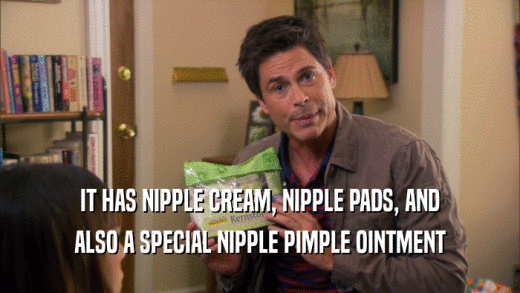

Chris responds to everything Ann is complaining about by providing his own solutions to them. Worse, he says that everything is amazing and today is perfect – totally disregarding her feelings. He makes it about him, not her.
Thankfully, Ron, Tom & Donna come in for the rescue:
Ron Swanson: You’ve fallen into a classic trap, Christopher: trying to fix a woman’s problems instead of just listening to what they are!
Tom Haverford: Hey man, if Ann needs Tylenol, she can get it herself. What she needs from you is to just look her in the eyes, nod your head, and say those two magic words.
Donna Meagle: That sucks.
Chris Traeger: That sucks?
Tom Haverford: I’ve spent my entire life reading instructional books about relationships in order to trick women into liking me. When Ann tells you what’s bothering her, don’t try to fix it. Just say, “Damn, that sucks.”
Long story short, they’re right. Ann loves that Chris always wants to help, but that’s not what she needed in this situation.
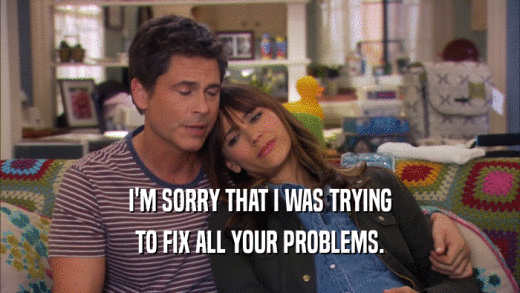
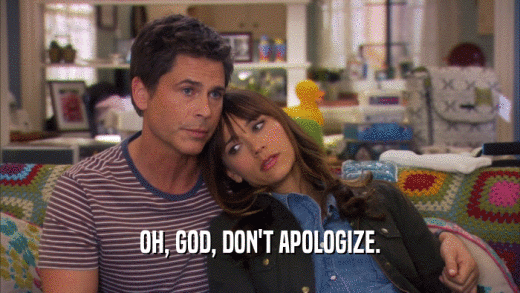
So next time someone close to you approaches you and shares about a tough situation, what’s your response? You may want to help fix everything for him or her, but maybe they just want you to listen and say to simple words: “that sucks”.
by Matthew Lau for the DoughMain Financial Literacy Foundation
Graphics made using Adobe After Effects & Instagiffer







Day 2: LAts of things to do
Our second day (still in LA) was jam-packed with exciting activities and beautiful sights. I learned that Los Angeles is no Manhattan; rather than being connected by subway lines, LA is connected by interstates.

‘
The Getty
TIf you don’t like art, maybe you can enjoy the garden. If you don’t enjoy gardens, enjoy the view of the waterfall or the skyline.
—
Griffith Park
My brother and I hiked the trail in the first picture below to the Griffith Observatory (next location in this post).
—
Griffith Park
Lala Land was filmed here and they do science/space stuff in here; view of the Hollywood sign one side, skyline on the other.
—
Grand Central Park
LA’s own little version of Chelsea Market!
—
Koreatown and LA Downtown
California Trip
My brother and I embarked on a 9 day trip in California during the end of May 2017. We started in LA.
Day 1
My brother and I landed in LAX and drove to our hotel in Santa Monica. Then we took an uber to Venice downtown. We walked through the Venice canals, and then walked a few miles along the beach from “Muscle Beach” in Venice all the way to Santa Monica Pier. The sun set during the end of the walk by the pier, but my favorite part of this was how active and lively the people were along the. Along the 3 miles we walked, people were working out at muscle beach, playing beach volleyball, rugby, basketball, biking, skateboarding with their dog, rollerblading, etc. I loved the energy. Below is a map of our walk, and a group of photos taken during the day, of course.

Venice Canal Historical District
—
Walk from Venice to Santa Monica
—
On the Santa Monica Pier
***BE A PART OF THIS BLOG!***
For each challenge, comment with an Instagram link or email me a photo (mattlau95@gmail.com). I want to add your pictures to each post!
With our smartphones today we live in a snapshot era. Having a camera at our fingertips results in the sharing of moments. When something exciting, beautiful, or bizarre meets the eye, we can immediately “snap and share.” These moments are intrinsically beautiful; however, the images used to share these moments lack image quality and often fail to provide capture any aesthetic appeal. However, I believe that with the combination of basic photography skills and an ounce of extra effort, the fleeting aesthetic can be captured. With that, I dare say that smartphones need smart pictures. For this blog sub-series I’m focusing on the how powerful a smartphone really is. All pictures will be taken from my iPhone SE and blog post composed on my WordPress app.
Post No. 1: Adding a Layer of Meaning to Pictures (Smartphones Need Smart Pictures No. 1)
What I’m talking about in this post is one of my favorite things to incorporate into a photograph. When capturing a moment, I always try and ask myself: “can I add anything to enhance this photograph?” For example, about a month ago, I bought a burger from a food truck (moment). I took a photo of that burger (primary layer). I positioned myself in a way to take the picture with the food truck blurred in the background (secondary layer).
Result:
Here’s another example that I just put together today in my room.
Moment: I saw that one my guitar picks looks like it’s melting due to wear and tear.
Primary Layer: holding my guitar pick with my left hand (taking the picture with my right).

How I add a quick secondary layer to this?
Secondary Layer: Guitar blurred in background.
Immediately there’s an extra layer in the picture- something more for one to look at. The focus is still on the guitar pick, with the guitar blurred in the background.
This aesthetic appeal is something we always do with human subjects. When we go on vacation and see a beautiful landmark (moment), we take a picture of ourselves (primary layer) with the landmark in the background (secondary layer).
Tip: To ensure the a blur in the background, it’s best when the primary layer is somewhat close to your camera. Also make sure that the camera is focused on that subject in the primary layer.
So I challenge you to incorporate this into your pictures!
Now the question is, can there be a third layer? I think so.
(Moment: Sunset at a beach in Fort Myers during Spring Break // Layer 1: shells on sand // Layer 2: beach and sky // Layer 3 (time): sunset)
And to conclude, heres the challenge for this post:
Challenge: With the examples shown above, try to do the same: add an extra layer (or more!) to a basic photo.
Comment with or send me your challenge results! Along with the image, if you have courage to try, tell me the moment and layers of your photograph. I can embed your Instagram post here right onto this blog!
Examples:
(Moment: Playing football with my buddy Josh // Layer 1 (focus): football // Layer 2 (blur): Josh smiling // Layer 3 (background): football field)

I’m in Fort Myers, Florida for spring break vacation right now, and the great weather has given me a great chance to see and photograph animals outdoors.
I took a picture of this squirrel this past week.

Do you see the ugly neon purple/pink color that surrounds the branches? Do you see the un-natural neon green as well? This is an example of chromatic aberration.
Chromatic aberration is an optics issue that occurs because different colors of light travel at different speeds when passing through a lens. The result can be manifested in color fringing– colored edges within the image. (Source: Photography Life).
This is something you can fix quite easily in Lightroom, using its Defringing tool.
NOTE: I’d love for you to use this image to follow along this color adjustment tutorial, so here’s the RAW file for this squirrel photograph: https://www.dropbox.com/s/imhw9m87hi98q23/Squirrel_Color_Fringing_Template_Matt_Lau.ARW?dl=0
Here’s the image before after making Lightroom color corrections to remove chromatic aberration/color fringing.
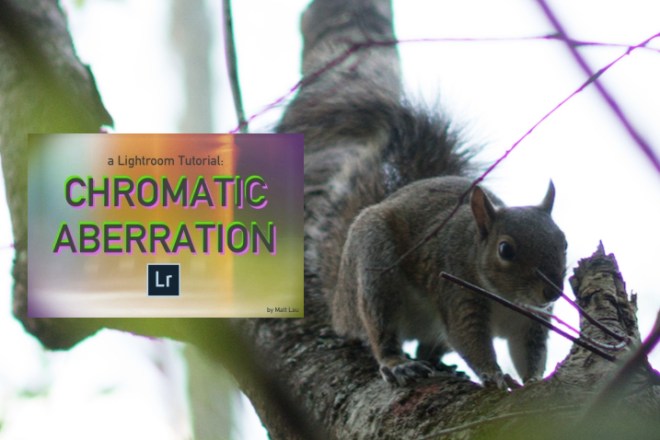
Step 0: Crop the Image.
Step 1: Find the Lens Correction Tab on the right hand side toolbar in Lightroom.
Step 2: Select the Color section.
Step 3: Click on the “Fringe Color Selector” (the dropper icon).

Step 4: Hover over the image.
With the dropper now “equipped,” you’ll see this palette of colors when you hover your mouse over the image.

Your selection will be the center square of the palette grid. Once you click on a spot, Lightroom will do its magic and remove purple fringing from your image.
Step 5: Click on a spot in the image where there is purple fringing.
Note: If you click on a color that Lightroom doesn’t recognize as purple/magenta or green/blue, the program will give you a nice error message and you can easily try again).

Lightroom’s magic will immediately remove some of that harsh neon purplish-pink-ish color. But not always enough, as the case here. There is still very terrible fringing in man parts of the image. One that particularly “sticks” out is the branch right above the squirrel’s right ear (viewer’s left-side). Pun intended 🙂
Step 6: Make manual adjustments.
Here’s when we want to manually mess around with the settings in the Color section of the Lens Corrections Tab.
Focus only on the first “Amount” horizontal bar and “Purple Hue” bar below it (these have to do with purple fringing. The two bars below are for green fringing).
Here are the settings I had for the squirrel image before after I manually adjusted the fringing:
Lightroom had used the color I had selected with the color picker and chosen to drastically defringe the image (Amount: 20) over a small Purple Hue range (32/45). After messing around with the settings myself,, I extended the Purple Hue range to 32/100, which removed a good amount of the purplish/pink that was still present in the image.
Here’s a look at our progression so far. No color adjustments -> Lightroom Auto-Adjustment –> Manual Setting Adjustment
Important Note: be EXTREMELY careful when performing color corrections on Lightroom. Always check the entire image and see if the color has affected anything else incorrectly. Sometimes when removing purple fringing too much, it will start to remove pink/red/purple color from the image (for example: purple clothing, dark red lipstick, etc.).
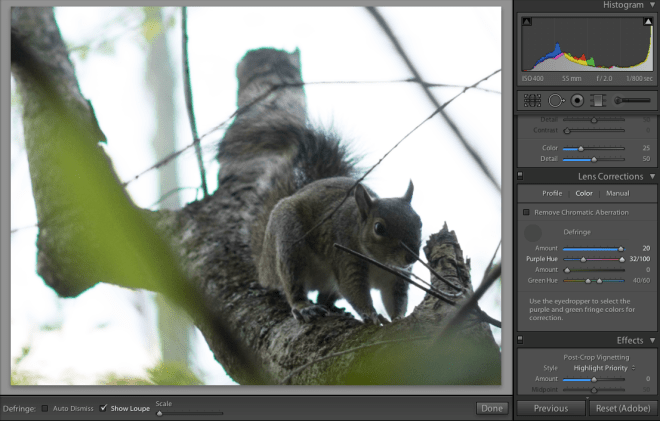
Step 7: Remove green fringing, using similar steps as before.
Alright. On to the green fringing. I’ll be less detailed- let you figure more of it out on your own!
Choosing the color selector again, I hovered over patch of cyan color on the twig to the upper left hand side of the squirrel’s tail, then clicked on the most neon grid.

Lightroom did a great job here. But there’s still a little cyan hiding around somewhere.

Can you find it?
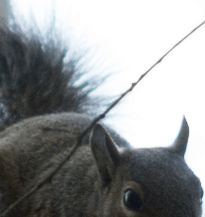
There’s a little bit in the fur of the tail, as well as the border of the squirrel’s left ear (your right side).
I would then adjust the Green Hue range to account for more blue (48/69 -> 48/100).
As you can see below, a good amount blue in the tail has disappeared.
Color corrections complete!
Step 8: Make image more sharper and/or more appealing.
Lastly I’m going to use the adjust the sharpness of the image and some basic light settings to make the image more vivid and appealing.
 Sharpening: (+) Sharpness – 77, (+) Radius – 1.5
Sharpening: (+) Sharpness – 77, (+) Radius – 1.5
Noise Reduction: (+) Luminance – 11, (-) Detail (under Luminance) – 7, (-) Detail (under Color) – 3
Then I just adjusted a few Basic light settings.

And alas, the final image.

Challenge #LR1: Try making color corrections on Lightroom to remove chromatic aberration. Feel free to use my image, or perhaps your own (which leads to Challenge #LR2)!
Challenge #LR2: Find a photograph of your own that you have taken in the past that has chromatic aberration in it, or take a new one! I’ve found that it occurs very often when a subject is in front of an overexposed (or very bright) sunlit background (for example, the squirrel’s background is the sun-lit sky).
Please comment with any questions you may have, or if there is any part of this tutorial that is unclear or difficult to understand. I would also love to the see any results you may have achieved while trying the challenges listed above. Until next time!
About a week has passed since the 2017 Academy Awards. A year after #OscarsSoWhte, this year’s Best Picture was awarded to Moonlight, a movie focused on African American.
Even then, the moment was somewhat overshadowed by the mixup that occurred as La La Land was mistakenly announced as the Oscar winner first.
Fortunately, both the creators of Moonlight and La La Land took this lightly. And the consensus is that Moonlight is truly a phenomenal movie that deserved the award, and so was La La Land. This year, one could say the Oscar winner for Best Picture wasn’t decided because of race. This is refreshing, especially during a time when tension race relations are still fuming.
However- to this day, the movie industry remains filled with cultural appropriation. Last year, I remember watching Tina Fey’s movie Whiskey Tango Foxtrot, which cast two whites to play significant Afghan roles. Pretty messed up… and I love Tina Fey.
This year, Matt Damon starred in The Great Wall as a European mercenary that saves China. Why is the protagonist role given to a white man? China is powerful country… it’s done just fine on it’s own. Many people of Chinese heritage, including myself, found this very ridiculous. Asian American comedian Jenny Yang started a hashtag trend to make fun of this: #ThankYouMattDamon. (Source: NJ.com)
It’s easy to be disappointed when seeing this. It makes no sense to have a character of a certain race be played by another. In other words, why should a white actor play the role of a Chinese warrior? White dominance has been something that affects the movie industry greatly; Aziz Ansari also addresses this issue within the TV industry in his Netflix show Master of None. I believe it’s present in photography as well- a topic I’m more versed in.
Then I thought: I have look at myself and my love for photography. Can I be found guilty of exercising unethical dominance over others in my own life?
I have. During a windy and torrential winter day last December, I was in New York City for a career networking event on 44th and 7th. I took a subway one stop uptown from Penn Station to Times Square. Exiting the Times Square subway station, I saw a couple seated on the floor. They were protected from pouring rain by the subway station entrance roof, but exposed to the harsh winter wind coming from outside.
I decided to photograph this scene. In fact, I even posted it on Instagram later on.
#homeless. What the heck was that for? Although the photo captured a beautiful moment as the female gently takes care of the man. I was eager to take a photo of this scene; at the same time, I was ashamed. I tried to be as nonchalant as possible, hoping no one would see me taking the photo.
Why? I took their photo and I captured a emotion-filled image, but I didn’t know their names. I didn’t donate any money or food to them. I’m privileged enough to enjoy photography as a hobby, while the subjects I had photographed don’t even have a place to call home. I was “borrowing” their homelessness for the sake of my photography.
Unethical photography has been an a topic of debate dating back to the 19th century, the century when photography was invented. Colonization and Imperialism in the 1800s played important roles in the origins of photography. Photographers would travel to other countries and photograph people from other civilizations.
Take a look here at a photograph of a Turkish woman by a French photographer Earnest Benecke:
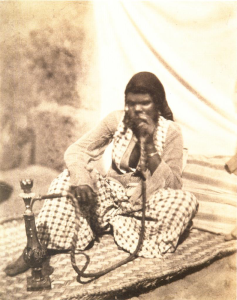
Photographs back then required exposure times that could take up to 30 seconds- this was not a candid. In my Art History class, we discussed the interaction that may have taken place between the German photographer and the Turkish woman. Did he pay her? Regardless, Benecke “borrowed” the Turkish woman’s “subordinate” culture for his own gain.
Here’s another photo taken in the 1990s:
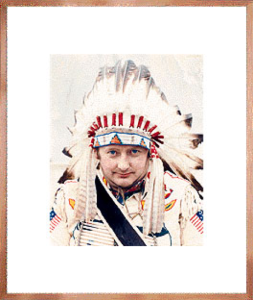
The man in the photograph is a white German, dressed up as a Native American Apache chief for his own leisure. This man “borrowed” the Native American headdress for his own pleasure.
This photograph would be an example of cultural appropriation, which when definite is “something that typically involves members of a dominant group exploiting the culture of less privileged groups — often with little understanding of the latter’s history, experience and traditions. … In the United States, cultural appropriation almost always involves members of the dominant culture (or those who identify with it) “borrowing” from the cultures of minority groups.”
(Source: http://racerelations.about.com)
In 2014, Pharrell Williams, music star and judge for NBC’s The Voice, wore a Native American feather headdress on the cover of Elle magazine.

Williams faced immediate criticism. Although he claims to have some Native American heritage, he apologized with a statement on Buzzfeed: “I am genuinely sorry. I respect and honour every kind of race, background and culture.” (Source: Independent UK)
The Indian Country Media Network made a statement: “Many of the people who are appalled by this image are deeply connected to their Native culture and live it every day. If they say the picture is hurtful, it’s hurtful, and a Cherokee grandmother doesn’t change that.” (Source: Independent UK)
Similarly, the professional football team Washington Redskins have faced countless backlash for using the mascot name “Redskins”– a term for Native Americans that is considered offensive. I’ll let one of my favorite comedians, John Oliver, speak for me here:
(Source: HBO’s Last Week Tonight with John Oliver)
One last example:
Afghan Girl by Steve McCurry (Source: National Geographic)
This was an award winning still by National Geographic’s photographer Steve McCurry. The woman in the photograph was a refugee living in Pakistan during a time of Soviet invasion in her home Afghanistan. Her parents were killed by a Soviet bomb. McCurry captured this photograph during a visit to a refugee camp and went on to achieve success and fame, while the woman in the photograph continued to live life of survival as a refugee. (Source: National Geographic)
The photograph was titled Afghan Girl. She didn’t even have a name. McCurry would eventually return to meet the woman (named Sharbat Gula) and take another photo to headline a “then and now” article for National Geographic. But even then, you could say McCurry “borrowed” this Sharbat’s suffering for his photographic success.

It’s easy for me to complain about the atrocity of these images. It’s not fair that Earnest Benecke in the 1800s to photograph this woman for his own fame. It’s messed up for someone to dress up as a Native American chief just for funsies-Pharrell Williams even apologized for it. It’s unethical for The Washington Redskins make millions while it’s name is derogatory and offensive. Steve McCurry added to his photographic legacy in America while the subject in his photo went on to live a difficult life as a Afghan refugee.
There are countless examples of this in our society today, but let’s return to my experience photographing a homeless couple in New York City. I would like to say that I wanted to capture the woman’s care for her ill partner as well as the homelessness that they are living through. But there’s still something inside me that bothers me- I didn’t help them, and I posted the photograph online on social media. My intent was for others to see my photograph- a photograph of people suffering nonetheless.
My final conclusion is somewhat open-ended. I believe that art can be a powerful tool to demonstrate people who are suffering and bring about empathy among viewers. When done successfully, an artist can gain success in the process. But in order to preserve their humility, artists must do their best to empathize for and take part in assisting the suffering people they are portraying in their own lives. I am financially privileged, yet I am “borrowing” this couple’s homelessness for the sake of my photography. I used the hashtag #prayforthehomeless, but am I actually praying for them and doing my best to care for the homeless in my own life?
Challenge D1: Take a look at the photographs around you on social media and see if you can find examples of cultural appropriation.
Challenge D2: Next time you post a picture on Instagram, Facebook, or even your Snapchat story, ask yourself what your reasoning is behind posting it. How does this picture help elevate a certain aspect about yourself that you want others to see? (Speaking honestly for myself, my Instagram is full of photographs where I want to elevate my reputation as an artist and as a photographer).
What do you think? Do you think photography can be unethical? Have you seen any examples of cultural appropriation? Please comment below!
Terms:
cultural appropriation – “cultural appropriation typically involves members of a dominant group exploiting the culture of less privileged groups — often with little understanding of the latter’s history, experience and traditions.”
-“In the United States, cultural appropriation almost always involves members of the dominant culture (or those who identify with it) “borrowing” from the cultures of minority groups.”
(Source: http://racerelations.about.com)